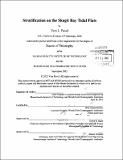Stratification on the Skagit Bay tidal flats
Author(s)
Pavel, Vera L. (Vera Lynn)
DownloadFull printable version (12.54Mb)
Other Contributors
Woods Hole Oceanographic Institution.
Advisor
Britt Raubenheimer.
Terms of use
Metadata
Show full item recordAbstract
Estuarine density stratification may be controlled primarily by cross-shore processes (analogous to longitudinal control in narrow estuaries), or by both cross- and alongshore processes (typical of coastal plumes). Here field observations and numerical modeling are used to investigate stratification on the low-sloped, periodically inundated Skagit Bay tidal flats. Advection of stratification by the depth-averaged velocity, straining of the horizontal density gradient by velocity shear, and turbulent mixing are shown to be the dominant processes. On the south-central flats (near the south fork river mouth) velocities are roughly rectilinear, and the largest terms are in the major velocity direction (roughly cross-shore). However, on the north flats (near the north fork river mouth), velocity ellipses are nearly circular owing to strong alongshore tidal flows and alongshore stratification processes are important. Stratification was largest in areas where velocities and density gradients were aligned. The maximum stratification occurred during the prolonged high water of nearly diurnal tides when advection and straining with relatively weak flows increased stratification with little mixing. Simulations suggest that the dominance of straining (increasing stratification) or mixing (decreasing stratification) on ebb tides depends on the instantaneous Simpson number being above or below unity.
Description
Thesis (Ph. D.)--Joint Program in Applied Ocean Science and Engineering (Massachusetts Institute of Technology, Dept. of Mechanical Engineering; and the Woods Hole Oceanographic Institution), 2012. Cataloged from PDF version of thesis. Includes bibliographical references (p. 79-84).
Date issued
2012Department
Joint Program in Applied Ocean Physics and Engineering; Woods Hole Oceanographic Institution; Massachusetts Institute of Technology. Department of Mechanical EngineeringPublisher
Massachusetts Institute of Technology
Keywords
Joint Program in Applied Ocean Science and Engineering., Mechanical Engineering., Woods Hole Oceanographic Institution.